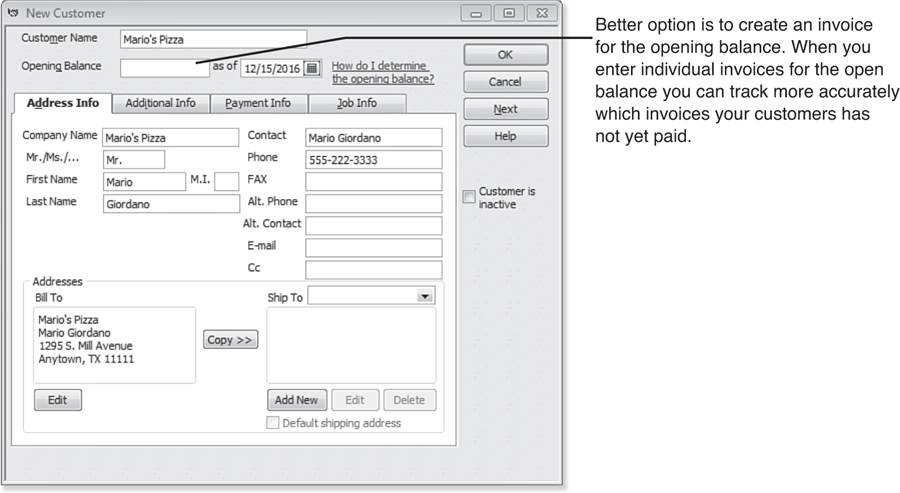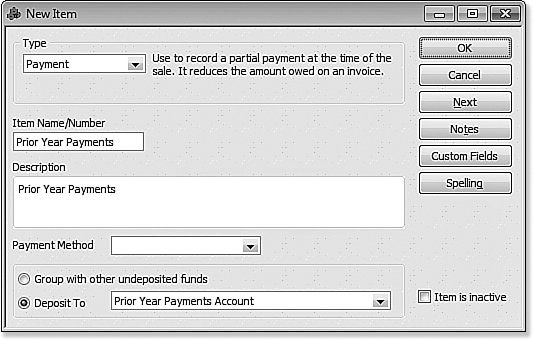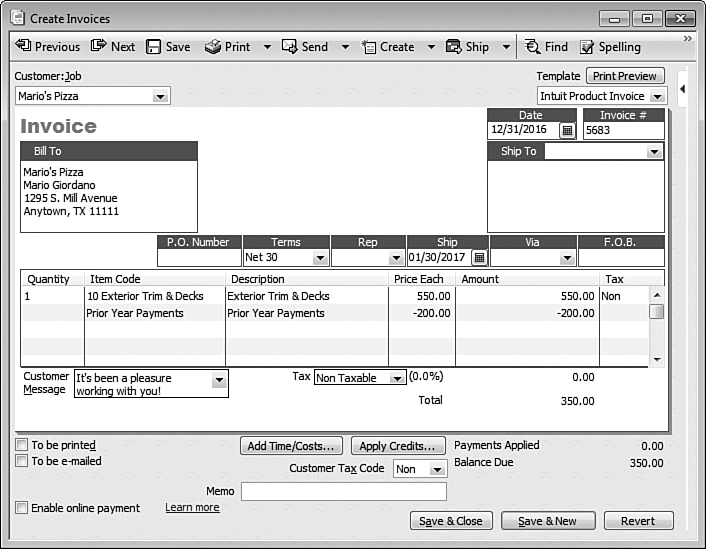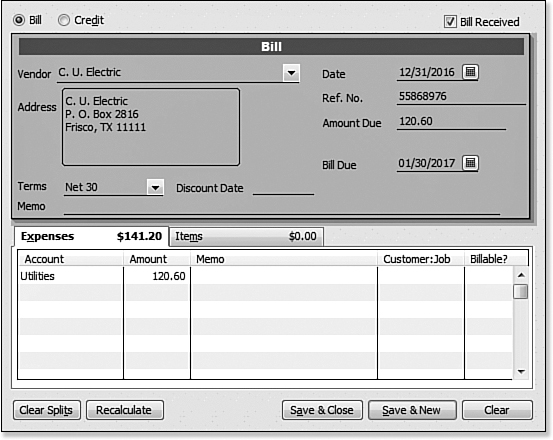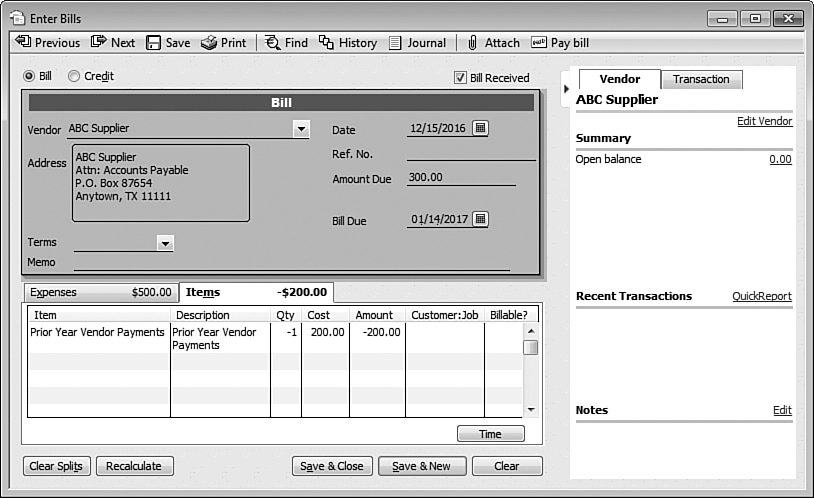3. Accounting 101
Basic Principles of Accounting
This chapter provides a quick review of some of the more important accounting concepts, written especially for the non-accountant business owner. While there is much more to learn about accounting principles than this chapter covers, you will learn at least enough to help you manage the financials of your business.
You made an important choice when you selected the QuickBooks software to help you track the day-to-day financial transactions of your business. QuickBooks completes most of the accounting behind-the-scenes, so you can focus on what you do best.
This book does not offer tax or accounting advice. Be sure to consult your accounting professional when necessary.
The Matching Principle
The matching principle of accounting refers to recognizing revenue and associated expenses in the same period. Matching income and costs in this manner gives you a much more accurate representation of your financial situation and performance.
Most businesses offer products or services that have related costs, such as:
• Asset Purchases—Balance Sheet accounts. Inventory for sale, or fixed assets (equipment) used in the production of your product or service.
• Cost of Goods Sold Expenses—Direct expenses incurred when making your product or providing a service. Cost of material or labor expenses are examples.
• Expenses—Overhead fixed and variable expenses such as rent, office supplies, advertising, and so forth.
• Other Expenses—Expenses of the business not related to the product or service you provide. For example, interest expense or depreciation expense.
Inventory you purchase is an asset purchase and later becomes a cost of goods sold expense when you sell it.
It is important to understand the different account types when recording costs, so that you will categorize your bills or expenses correctly.
![]() For more information, see “Account Types,” p. 78.
For more information, see “Account Types,” p. 78.
Any discussion of the matching principle isn’t complete without defining revenue. Revenue (income) is usually the funds received from customers. Income is typically one of the following:
• Operating Income—Income derived from selling your business’s product or service.
• Other Income—Income derived from sources other than selling your product or service. For example, interest income.
I expect that you already understand the general concept of revenue versus expense. So what does the matching principle have to do with accounting?
A retail bike store might keep parts, such as wheels, pedals, and chains on hand in its inventory so it can assemble bicycles for its customers. The matching principle requires this store to record the costs of the bike at the time of sale. The initial purchase of inventory is not an expense, it is simply trading one asset, cash, for another asset, inventory. When the asset is sold, the initial purchase cost becomes an expense, which reduces the resulting revenue.
Inventory management, as discussed in this example, is pretty straightforward. QuickBooks will track your initial purchase as an asset, and then record the average cost of each part as an expense when you create an invoice to record the sale to a customer.
![]() For more information, see “Setting Up Inventory,” p. 111 and “Managing Inventory,” p. 159.
For more information, see “Setting Up Inventory,” p. 111 and “Managing Inventory,” p. 159.
However, let’s tackle something a bit more difficult. In this same business, you are required to pre-pay six months of general liability insurance. Recording this entire balance as an expense in a single month would make that month’s net income appear artificially lower, along with making net income for the next five months artificially higher. To match the expense, you would assign the initial payment to a prepaid expenses account on your balance sheet. You would then use a journal entry each month to record an increase in insurance expense and a decrease in the prepaid expenses account. Each month would then have the cost for insurance that belonged in a single month.
![]() For more information, see “Recording Vendor Prepayments,” p. 245.
For more information, see “Recording Vendor Prepayments,” p. 245.
QuickBooks accrual basis reporting can help view your financials in a format that matches revenue with expense. More information is provided in the next section.
Accrual Versus Cash Basis Reporting
Although the purpose of this book is not to give specific accounting or tax advice on any of the topics covered, it is worth discussing the nature of accrual versus cash basis reporting as it pertains to creating a new data file.
Cash basis accounting follows these rules:
• Revenue—Recognized when the customer payment is received, not necessarily the same day or month the service or product was provided.
• Expenses—Recognized when the payment is made to the vendor or employee, not necessarily the same day or month the expense relates to.
Accrual basis accounting follows these rules:
• Revenue—Recognized as income on the date of the customer invoice transaction regardless of when the customer pays the invoice.
• Expenses—Recognized as a cost on the date of the vendor bill, check, or credit card charge, regardless of when you make the payment.
Understanding the basics of these two types of reporting is important. When filing a tax return, businesses must specify cash or accrual as their accounting method. However, for management purposes, business owners can view one or both types of reports when making internal decisions. The capability to view reports in either accrual or cash basis is one of the features that sets the QuickBooks software apart from other accounting solutions.
Cash basis reporting can give you a sense of how cash flows through your business, while accrual basis reporting uses the matching principle to give you a much more accurate representation of how revenue and expenses are related.
The difference between the two methods is in the timing of when income and expenses are recognized in your financials. Table 3.1 shows how QuickBooks treats the different types of transactions in both reporting methods on the Profit & Loss statement.
Table 3.1. Accrual Versus Cash Basis Accounting

In QuickBooks preferences you can set a global default basis for all reports. Log into the file as the Admin or External Accountant user type, and from the menu bar, choose Edit, Preferences, Reports & Graphs. Select the Company Preferences tab and choose Accrual or Cash from the Summary Reports Basis section. You can also modify the basis of many reports individually. From a displayed report, select Customize Report and select Accrual or Cash in the Report Basis section.
For management analysis, I encourage every business owner to view their financials often using accrual basis reporting. When you review accrual basis reports, you can see trends from one period to the next. Management decisions based on accrual basis reports might be very different when making the same decisions based on cash basis reports.
Basic Financial Reports
This section describes financial reports that are key to your business.
![]() For more details on working with reports, see “Reviewing Your Data,” p. 495.
For more details on working with reports, see “Reviewing Your Data,” p. 495.
Balance Sheet
The balance sheet represents the overall financial health of the business. Of the financial statements detailed here, the balance sheet is the only statement that applies to a single date in the business’ calendar year.
A standard company balance sheet has three sections and is represented by this equation: Assets = Liabilities + Equity. The categories include:
• Assets—Cash, along with economic resources that can be converted to cash.
• Current Assets—Cash, accounts receivable, inventory, and pre-paid expenses to name a few.
• Fixed Assets and Depreciation—Buildings and equipment and their depreciation.
• Other Assets—Goodwill, trademarks, and copyrights.
• Liabilities—A debt the business is obligated to pay.
• Current Liabilities—Debt that typically will be paid back within one year.
• Long-term Liabilities—Debt that is expected to take longer than one year to pay back.
• Equity—Owner’s investments and draws and residual net income or loss in the business over time.
Business owners should review the balance sheet as often as they review the income statement. Most business owners that review the balance sheet will have a pretty good idea if the information is accurate just by looking at the balances.
Income Statement
The income statement also is referred to as a profit and loss statement in QuickBooks. My experience over the years is that business owners review this report often. In QuickBooks, a simple income statement includes these basic sections:
• Income—Monies received from the sale of products and services.
• Cost of Goods Sold—Direct costs of producing your product or service.
• Gross Profit—Income less cost of goods sold.
• Expense—Costs associated with your business that aren’t directly related to producing goods or services, often referred to as overhead.
• Net Ordinary Income (Loss)—Income or loss from operations.
• Other Income/Expense—Income or expense not related to operations, such as interest income or interest expense.
• Net Income (Loss)—Income or loss from operations less other income/loss.
QuickBooks offers you the flexibility to review your Profit & Loss Standard report in either accrual or cash basis. Creating an income statement that shows 12-month periods on the accrual basis makes it easy to spot changes and trends from period to period.
Statement of Cash Flows
The primary purpose of this report is to show the sources and uses of cash in the business. The statement of cash flows includes the following groups:
• Operating activities
• Investing activities
• Financing activities
Additionally, the following information is included in the statement of cash flows report:
• Net cash increase for the period
• Cash at the beginning of the period
• Cash at the end of the period
QuickBooks automatically assigns a specific chart of accounts to cash flow report categories based on the account type selected.
You also can manually assign a chart of accounts to a specific section of the statement. You must log into the file as the Admin or External Accountant user to set this preference. From the menu bar, select Edit, Preferences, Reports & Graphs, and select the Company Preferences tab. Click the Classify Cash button and follow the instructions on the screen.
Other Accounting Reports
The reports references are simply the basic reports used to analyze the financial health of a business. There are many other reports worth reviewing. Many chapters in this book include sections that detail specific reports relevant to the topic.
Accounting Checklist to Help You Manage Your Financials
This checklist is provided to help the business owner or accounting professional take an organized approach to periodically reviewing a QuickBooks file. This book includes several chapters that will help you learn how to accurately and efficiently manage your data.
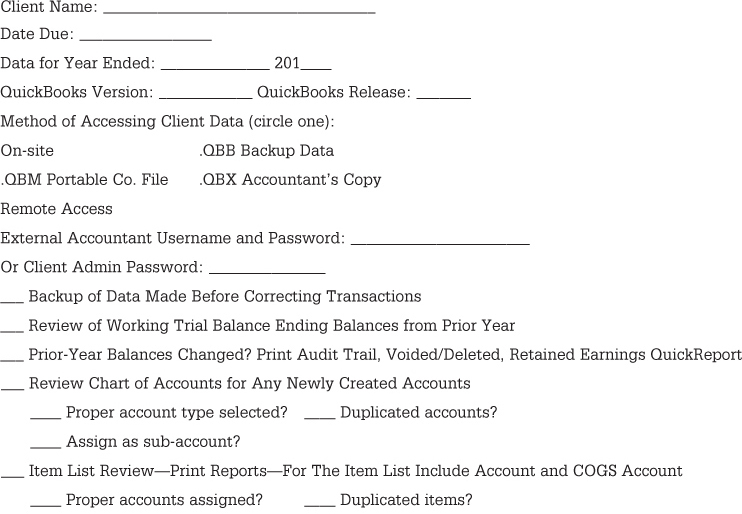

Setting Up a QuickBooks Data File for Accrual or Cash Basis Reporting
If you have just recently started a new business and QuickBooks is the first financial tracking software you have used, rest easy. You can skip this section because QuickBooks makes it possible for you to do the daily tasks of paying vendors or employees and invoicing customers without any complicated startup procedures. Later, you can view reports in either cash or accrual basis.
However, you may have to manually enter open customer, vendor, and bank balances, in addition to additional balance sheet balances if you are converting to QuickBooks from a software application other than those currently supported with the QuickBooks conversion tool.
![]() For more information, see “Converting from Other Accounting Software,” p. 34.
For more information, see “Converting from Other Accounting Software,” p. 34.
When you begin using QuickBooks you will need to define a start date—the date you first want QuickBooks to track your financial accounting. If the business had expenses or sold products and services before this start date, you most likely have open transactions. For example, if your start date is January 1, 2017, then your beginning balances would be dated as of December 31, 2016.
The following is a brief list of what you need to collect when creating a new QuickBooks data file. These lists should represent their respective value as of the day before your QuickBooks start date:
• Accounts Receivable—List by customer of what customers owed you on the day before your start date, including any invoices where the payment was received, but not deposited by the start date.
• Accounts Payable—List by vendor of those bills you had not paid as of your start date.
• Bank Ending Balance—Ending balance from your bank statement on the day before your start date.
• Uncleared Checks and Deposits—List of all checks and deposits that have not yet cleared your bank account as of your start date.
• Other Balances—List of all other assets, liabilities, and equity you have in the business.
• Payroll—Year-to-date totals for each employee (if using payroll in QuickBooks).
To get your QuickBooks data ready for entering current transactions, you need to record these open balances. However, before doing so, you need to have a few things already set up in QuickBooks. You might refer to the following items as “Master Lists.”
The following options are available when you are creating startup or opening transactions for a business for which you are beginning to use QuickBooks after previously using some other software or manual accounting method.
Cash or Accrual Basis Startup Transactions: Accounts Receivable
After you have completed creating your new data file, you need to take some additional steps that are important to the successful setup of your new QuickBooks file.
To create a customer or job from the Customer Center, select New Customer & Jobs or select the menu to Add Multiple Customer:Jobs. You can enter an opening balance in the New Customer or New Job dialog box (see Figure 3.1). However, as I explain in this section, I don’t recommend entering the beginning balance here.
Figure 3.1. The Opening Balance field in a New Customer dialog box.
When you enter an amount in the Opening Balance field on a new Customer or Job record, QuickBooks will create a single invoice for the entire amount owed, whereas your own records may include multiple invoices for the amount owed. Additionally, when preparing cash or accrual basis reports take this into account:
• Accrual Basis Reporting—For this type of reporting, the Opening Balance field increases Accounts Receivable (debit) and increases Uncategorized Income (credit) assigned the date in the “as of” field on the New Customer or New Job dialog box.
• Cash Basis Reporting—For this type of reporting, the field has no effect until the date of customer payment. When the customer payment is received, it increases (debit) the account you assign to customer payments (either the QuickBooks Undeposited Funds or the bank account) and increases Uncategorized Income (credit).
You might well imagine that recording open customer invoices in the New Customer or New Job dialog box is generally not recommended. Instead, follow these steps to create open customer invoices as of your start date:
1. From the menu bar, select Customers, Create Invoices (see Figure 3.2).
Figure 3.2. Create an open customer invoice.
2. Select the customer or job from the Customer:Job drop-down list.
To access this dialog box, you also can use the shortcut key Ctrl+I or access it directly from the opening screen in QuickBooks, known as the Home page.
3. Enter the original invoice date in the Date field (it should be before your start date).
4. Enter the originally assigned invoice number.
5. In the Item column, enter the item(s)—the products or services that were sold—if you want to accurately track your revenue from this item. It should be the same item(s) that appeared on the original invoice to the customer.
6. If applicable, enter a value in the Quantity column.
7. If the rate did not prefill (because it was not included when the list item was created), enter a value in the Rate column.
8. The correct tax status on the line should prefill if the list item was set to the proper sales tax status. If some customers pay sales tax and others do not, you must first indicate the taxable status of an item by clicking Lists, Item List. Highlight the item in question, select the Item button, and select Edit Item. The Edit Item dialog box opens, and you can mark the item with the appropriate sales tax code.
QuickBooks first determines whether an item is taxable, and then it checks whether the customer is a sales tax–paying customer before assessing sales tax on a customer balance.
9. Make sure the To Be Printed and To Be E-mailed check boxes in the lower left are not selected. However, you will want to select the appropriate box here when you create your first new invoice in QuickBooks. Going forward, QuickBooks will remember the setting from the last saved or edited invoice.
10. Check your Balance Due to make sure it agrees with the list item total from which you are working.
11. Click Save & Close if you are finished, or click Save & New if you have more invoice transactions to record.
Cash or Accrual Basis Startup Transactions: Accounts Payable
Accounts Payable startup refers to those vendor bills that were not paid as of your start date. Presumably, these are the vendor bills you will be paying out in your first month of using QuickBooks.
Correctly setting up the starting Accounts Payable balance is just as important to your financials as setting up Accounts Receivable.
Entering invoices using the method described in the side bar provides you with sales reports by item. If this level of detail is not needed on past transactions, you could simply enter a net amount due on the invoice.
1. From the menu bar, select Vendors, Enter Bills. From the Vendor drop-down list select the appropriate vendor (see Figure 3.5).
Figure 3.5. Enter a vendor bill that was unpaid at your start date.
2. Enter the bill Date. This date should be on or before your QuickBooks start date, and it is often the date on the vendor’s bill you received.
3. Enter the vendor’s bill number in the Ref. No. field. This serves two important purposes: One is to optionally print the reference number on the bill payment stub that is sent to the vendor, and the other is to allow QuickBooks to warn you if a duplicate bill is later entered with the same Ref. No.
4. Enter a number in the Amount Due field, if you previously paid part of the bill; the amount should equal the balance remaining to be paid. (See the sidebar “Partially Paid Open Vendor Bills on Cash Basis Reporting.”)
5. QuickBooks defaults the Bill Due date to the terms specified on the Additional Info tab in the New Vendor or Edit Vendor dialog box; however, you also can override the Bill Due date on this screen, if necessary.
6. Click the Expenses tab and assign the appropriate expense account. If you are tracking costs by items, use the appropriate item on the Items tab. In accrual basis, the account or item selected is not as important because the expense was recorded on the vendor’s bill date in your previous software or accounting method. For cash basis, it is most important because the cost is recorded to the expense account or item not when the bill is dated, but on the date of the bill payment check transaction, which should occur after the start date.
8. From the menu bar, select Report, Vendors & Payables, A/P Aging Summary (or A/P Aging Detail), and compare the totals with your previous accounting software or manual records.
9. If the open bills you are entering are for inventory, make sure you read the details in Chapter 5, “Setting Up Inventory.”
Cash or Accrual Basis Startup Transactions: Bank Account Statement Balance
In addition to setting up the Accounts Payable and Receivable startup transactions, you also must record the balance the bank had on record as of the start date. Having accurate information is necessary when you are ready to reconcile the bank account in QuickBooks to the bank’s records.
To track these expenses using one of the many Job Profitability reports, you need to enter your cost detail on the Items tab of the related dialog box.
To create your beginning bank balance, follow these steps:
1. From the menu bar, select Banking, Make Deposits to record your bank statement balance (if a positive balance). However, if you have been using QuickBooks for recording payments before you entered your beginning bank balance, you may need to close the displayed Payments to Deposit dialog.
2. In the Deposit To field, enter your bank account from your chart of accounts list. The Date should be the same as your bank statement ending date, usually the day before your QuickBooks start date.
3. Select Opening Balance Equity from the From Account drop-down list (see Figure 3.8). The balance really belongs in Retained Earnings, but posting it here first gives you a chance to make sure the opening entries for your cash account are correct. (See Chapter 13, “Working with Bank and Credit Card Accounts,” for a complete discussion on moving the Opening Balance Equity balance to Retained Earnings.)
Figure 3.8. Entering the statement ending balance from the bank.
4. Enter an optional Memo.
To check if your bank account has the correct balance, from the menu bar, select Banking, Use Register, and select your bank account to open the register.
If the amount is correct and agrees with your bank’s statement ending balance, no further action is required. Otherwise, double-click the transaction and edit the amount. If you don’t yet have a beginning balance, follow the steps listed in this section.
5. Enter the Amount. The amount recorded here is the ending balance from the bank statement the day before your QuickBooks start date. This amount should not include any uncleared checks or deposits that have not cleared the bank funds.
6. Click Save & Close to record the transaction.
If your bank account had a negative balance as of your start date, you can use a check to record that amount.
If you have outstanding deposits that did not clear your bank funds, the way you enter them depends on the basis of accounting used:
• Accrual basis users create the deposit(s) using the same steps as outlined for entering the beginning bank balance and date the transactions before the start date.
• Cash basis users select Customers, Receive Payment from the menu bar, and apply the deposit to an open invoice, which you created earlier in this chapter. Date this transaction on or after your start date.
Cash or Accrual Basis Startup Transactions: Recording Uncleared Bank Checks
You are almost finished with the startup entries. The last thing to do is to record the checking account’s uncleared checks and debits, as shown in Figure 3.9. To complete the startup process for your banking transactions, follow these instructions to create your uncleared checks:
1. From the menu bar, select Banking, Write Checks.
2. In the Write Checks dialog box, enter the actual check number that was issued in the No. field.
3. Enter the date of the original check in the Date field, which should be before the start date.
4. Select the payee from the Pay to the Order Of drop-down list.
5. Enter the amount of the check.
6. Enter the Opening Balance Equity account on the Expenses tab (see Figure 3.9). (This account is used because in both accrual and cash basis reporting, the check expense amount was included in our prior software or accounting method Profit & Loss totals.)
7. Click Save & Close (or Save & New) until you are completed with this task.
Figure 3.9. Entering a check that was not cashed by the bank as of the start date.
To verify the accuracy of the information, select Reports, Company & Financial, Balance Sheet Standard from the menu bar, and set the date to be one day before your start date. Your bank account balance(s) should be equal to Bank Statement Ending Balance plus Outstanding (uncleared) Deposits less Outstanding (uncleared) Checks.

